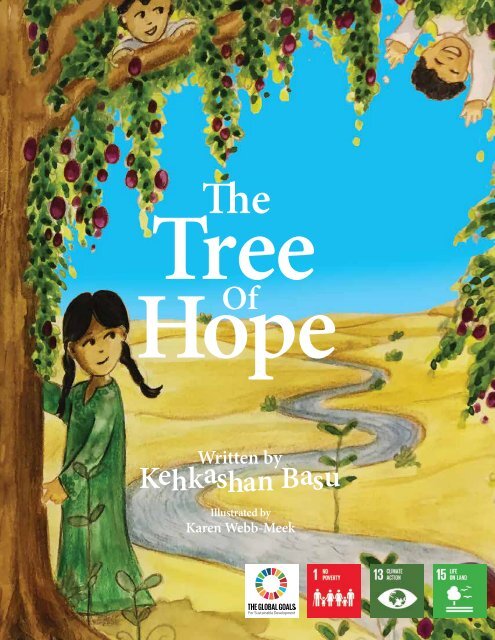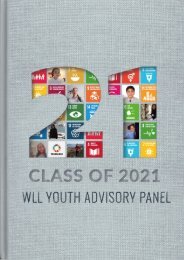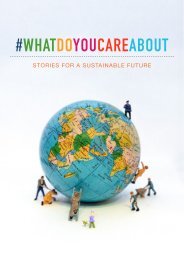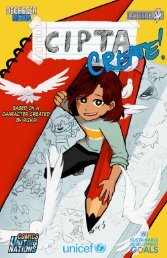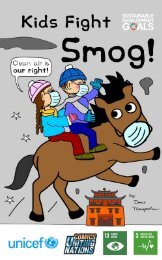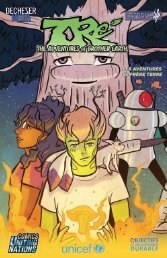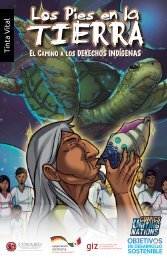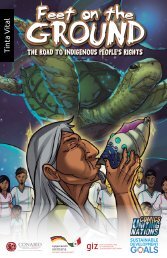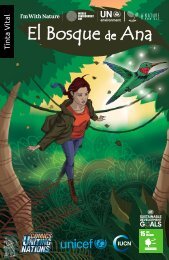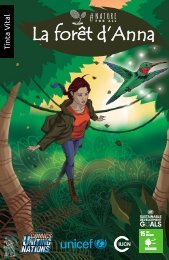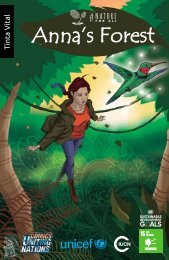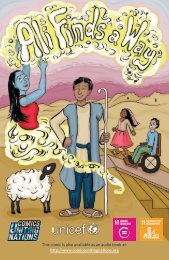The Tree of Hope
Create successful ePaper yourself
Turn your PDF publications into a flip-book with our unique Google optimized e-Paper software.
<strong>The</strong><br />
<strong>Tree</strong><br />
<strong>Hope</strong><br />
Of<br />
Written by<br />
Kehkashan Basu<br />
Illustrated by<br />
Karen Webb-Meek<br />
1
Published and distributed by:<br />
Voices <strong>of</strong> Future Generations International Children’s Book Series<br />
Trust for Sustainable Living<br />
Hampstead Norreys, Berkshire, RG18 0TN, United Kingdom<br />
Tel: +44 (0)1635 202444<br />
Web: www.v<strong>of</strong>g.org<br />
Special thanks to René V. Steiner for layout and graphics support:<br />
www.steinergraphics.com.<br />
Text © Kehkashan Basu 2017<br />
Illustrations © Karen Webb-Meek 2017<br />
<strong>The</strong> Voices <strong>of</strong> Future Generations International Children’s Book Series:<br />
‘<strong>The</strong> Epic Eco-Inventions’ by Jona David (Europe/North America), illustrated by Carol Adlam<br />
‘<strong>The</strong> Great Green Vine Invention’ by Jona David (Europe/North America), illustrated by Carol Adlam<br />
‘<strong>The</strong> <strong>Tree</strong> <strong>of</strong> <strong>Hope</strong>’ by Kehkashan Basu (Middle East), illustrated by Karen Webb-Meek<br />
‘<strong>The</strong> Fireflies After the Typhoon’ by Anna Kuo (Asia), illustrated by Siri Vinter<br />
‘<strong>The</strong> Species-Saving Time Team’ by Lautaro Real (Latin America), illustrated by Dan Ungureanu<br />
‘<strong>The</strong> Sisters’ Mind Connection’ by Allison Lievano-Gomez (Latin America), illustrated by Oscar Pinto<br />
‘<strong>The</strong> Forward and Backward City’ by Diwa Boateng (Africa), illustrated by Meryl Treatner<br />
‘<strong>The</strong> Voice <strong>of</strong> an Island’ by Lupe Vaai (Pacific Islands), illustrated by Li-Wen Chu<br />
‘<strong>The</strong> Visible Girls’ by Tyronah Sioni (Pacific Islands), illustrated by Kasia Nieżywińska<br />
‘<strong>The</strong> Mechanical Chess Invention’ by Jona David (Europe/North America), illustrated by Dan Ungureanu<br />
CISDL<br />
Centre for International<br />
Sustainable Development Law<br />
This book is printed on recycled paper, using sustainable and low-carbon printing methods.<br />
2
<strong>The</strong><br />
<strong>Tree</strong><br />
<strong>Hope</strong><br />
Of<br />
Written by<br />
Kehkashan Basu<br />
Illustrated by<br />
Karen Webb-Meek<br />
3
4
5
6
7
8
Foreword<br />
At the World Future Council, we are dedicated to pass on a healthy<br />
planet to our children and grandchildren. As a strong voice<br />
speaking out for the rights <strong>of</strong> future generations, we are working<br />
to close the growing gap between what we should be doing, and<br />
what is being done right now. I am very happy to see that this<br />
book series is already such a success. It aims to provide a voice<br />
for you, the youth <strong>of</strong> today, and hopefully inspires you to become<br />
active yourself ! Through these stories, we share two key promises<br />
that the world has made to you and to future generations: <strong>The</strong><br />
Convention on the Rights <strong>of</strong> the Child and <strong>The</strong> Future We Want<br />
Declaration. This second book, written by our Youth Ambassador Kehkashan Basu, is<br />
an inspiring story <strong>of</strong> a girl who makes a difference, rising beyond conflict and drought,<br />
by planting and caring for trees, to benefit her whole community.<br />
— Jakob von Uexküll<br />
Founder and Chair, Management Board, World Future Council and<br />
Founder <strong>of</strong> the Right Livelihood Award<br />
9
10
Preface<br />
This year is crucial as world leaders will agree on a new sustainable<br />
development framework for the next 15 years during the United<br />
Nations Summit for the adoption <strong>of</strong> the post-2015 agenda. <strong>The</strong><br />
proposed 17 goals include targets to end poverty, to ensure healthy<br />
lives and quality education and to combat climate change, among<br />
others.<br />
This platform will be followed by a new global pact to stop<br />
climate change this December in Paris. <strong>The</strong> decisions taken will<br />
undoubtedly have a huge impact on children’s lives and rights today as well as the lives<br />
and rights <strong>of</strong> future generations. Climate change is a clear violation <strong>of</strong> children’s and future<br />
generations’ right to life and well being.<br />
This book introduces Khadra to us, a young girl living in a desert landscape and describes how<br />
she turned her place into an oasis. We need vision, will and engagement towards a just society<br />
and a healthy planet. I strongly believe that we should listen to children and youth seriously<br />
and support their active role in creating a world where they can grow and develop in a safe and<br />
stable environment, and also in societies that are free <strong>of</strong> injustice and inequality.<br />
— Maria Fernanda Espinosa<br />
Permanent Representative <strong>of</strong> Ecuador to the UN in Geneva,<br />
Former Minister <strong>of</strong> Foreign Affairs, Councillor <strong>of</strong> the World Future Council<br />
11
In a small village on the edge <strong>of</strong> a vast, harsh<br />
desert lived a little girl, Khadra, and her mother.<br />
<strong>The</strong> sun beat down unforgivingly on her village<br />
from early morning until night, soaking up all<br />
the moisture.<br />
12
<strong>The</strong> heat was especially<br />
unforgiving during<br />
midday and drove<br />
everyone indoors.<br />
13
14
Like any other little girl, Khadra hated being<br />
cooped up inside the house and wanted<br />
desperately to play outside with her friends,<br />
but her mother would have none <strong>of</strong> it. She<br />
was afraid that Khadra would get a heat<br />
stroke if she spent the afternoon outside.<br />
So, Khadra spent the long afternoons staring out <strong>of</strong> the<br />
window at the undulating sands which shimmered in the<br />
heat-haze and she waited for dusk so that she could go<br />
out and play.<br />
She longed for the weather to change so that she could<br />
spend more time outdoors. She loved her home and<br />
village but wished that it was a little less hot and sunny.<br />
Little did she realise that very soon she<br />
would have the answer to her dreams.<br />
15
One morning, Khadra was woken up early<br />
by her mother, who asked her to go to the<br />
village well to fetch water. Water was very<br />
precious in her village and the single well<br />
at the village square was its only source.<br />
Every day, there were long queues at the well <strong>of</strong> residents<br />
waiting for a turn to haul up their daily requirement<br />
<strong>of</strong> water.<br />
On that day, Khadra’s mother asked her to go early and<br />
get some water because she was expecting a guest at<br />
their house and wanted to finish cooking in time for his<br />
arrival.<br />
16
It was a chore which Khadra<br />
enjoyed as she met most <strong>of</strong><br />
her friends at the well. She also<br />
loved the splashy sound <strong>of</strong><br />
water and its cool, soothing feel.<br />
<strong>The</strong> well was very deep and looked<br />
a bit scary as she peered over the<br />
parapet...<br />
17
That day, she hurriedly collected the water, slung the bucket on<br />
her back and hurried back home as she, too, was excited at the<br />
prospect <strong>of</strong> meeting the guest.<br />
Khadra did not really know<br />
who he was, except that he<br />
was her mother’s distant<br />
cousin who was a traveller<br />
<strong>of</strong> sorts.<br />
Khadra loved to listen to<br />
stories, especially <strong>of</strong> distant,<br />
exotic, faraway lands and<br />
hoped that her visiting uncle<br />
would have a tale or two for her.<br />
18
Khadra’s uncle finally arrived in<br />
the hot afternoon carrying a<br />
very big bag behind him.<br />
19
He had a craggy but friendly face with the most twinkly<br />
eyes Khadra had ever seen. Kahra was very intrigued by<br />
him.<br />
20
She couldn’t wait for meal time to be over, as she<br />
wanted to hear stories <strong>of</strong> her uncle’s travels.<br />
She was also very curious to find<br />
out what was inside her uncle’s<br />
heavy bag which he had placed<br />
carefully by the door.<br />
21
Finally, lunch was over and her mother went into<br />
the kitchen to clean up, warning Khadra to not<br />
pester her uncle and to allow her uncle to rest.<br />
Her uncle smiled at the crestfallen look on Khadra’s<br />
face and whispered to her that he wasn’t really tired<br />
and would love to chat with her. Delighted, Khadra<br />
started asking him to tell her his most recent adventures.<br />
22
Her uncle said that he had recently been to<br />
another part <strong>of</strong> the world which had the<br />
most amazing forests and trees.<br />
He described how<br />
many years ago<br />
that part <strong>of</strong> the<br />
world was also<br />
barren and dry -<br />
much like Khadra’s<br />
village, but somehow<br />
the local people had found<br />
a way <strong>of</strong> changing all that.<br />
23
<strong>The</strong>y had found a plant which could grow<br />
and flourish with very little water.<br />
Every time there was a happy occasion,<br />
like a birthday or a wedding, they planted<br />
a sapling to celebrate the event..<br />
<strong>The</strong> intention was to<br />
encourage people to<br />
plant more trees.<br />
Soon, over time, the<br />
whole area became<br />
green.<br />
As if to prove his point, Khadra’s uncle<br />
asked her to bring his bag. Telling her<br />
to be careful, he invited her to open it.<br />
With excited fingers, Khadra untied<br />
the strings, and to her surprise it was a<br />
small sapling in a pot. <strong>The</strong> plant had very<br />
strange leaves... thick and leather-like.<br />
24
Her uncle said that the leaves were special and<br />
they stored water. This was the plant’s speciality.<br />
<strong>The</strong> plant was capable <strong>of</strong><br />
storing every drop <strong>of</strong><br />
available water from<br />
its surroundings, thus<br />
enabling it to survive<br />
long periods <strong>of</strong><br />
drought.<br />
Khadra’s uncle said that<br />
this tree was a gift from<br />
him to her. He told her<br />
that her name meant<br />
green in Arabic and that<br />
maybe she was destined<br />
to be the person to seed<br />
her village’s landscape<br />
with the colour green.<br />
25
Khadra<br />
was overjoyed.<br />
This was<br />
the most exotic<br />
gift she had ever<br />
received. She gave<br />
her uncle a big<br />
hug and ran to her<br />
mother to share her<br />
excitement.<br />
Before leaving, her uncle explained to Khadra<br />
how to plant and take care <strong>of</strong> the tree. He told<br />
her to find a place in her backyard which was<br />
in the shade and to plant it there.<br />
He also told Khadra to save a mug <strong>of</strong> water from her<br />
bath every day and use it to water the plant.<br />
It needed very little water, he explained, as it<br />
survived on the morning dew.<br />
26
As he departed, he reminded<br />
Khadra that once the tree had<br />
grown, she should collect the<br />
seeds from the plant's fruits.<br />
He told her to give these<br />
seeds to her friends on their<br />
birthdays, and to encourage<br />
them to also plant the trees.<br />
He hoped Khadra would<br />
take on the responsibility<br />
to live up to her name.<br />
27
28
That evening, Khadra gathered<br />
her friends in her backyard<br />
and narrated to them the<br />
events <strong>of</strong> the afternoon.<br />
She showed them the plant which she<br />
had been gifted by her uncle. Together<br />
they dug a hole and planted the<br />
sapling.<br />
29
Time passed<br />
and Khadra’s<br />
sapling flowered and<br />
grew into a large, imposing tree.<br />
Its branches and leaves <strong>of</strong>fered shade<br />
during even the harshest <strong>of</strong> summers.<br />
No longer did Khadra have to stay cooped up<br />
indoors during the afternoons. She, along with<br />
her friends, spent happy hours sitting under<br />
the tree’s shade or up in its leafy branches.<br />
30
31
Birds that had never before been seen in the village<br />
miraculously appeared and nested in the tree’s<br />
branches.<br />
32
<strong>The</strong>ir morning songs now woke Khadra up every day.<br />
33
34
Following her uncle’s instructions, her friends<br />
plucked the tree’s berries and planted the seeds<br />
in their backyards.<br />
<strong>The</strong> village elders looked<br />
on indignantly at the children’s<br />
antics,<br />
with some shaking<br />
their heads, as if<br />
to say that it<br />
was all a<br />
waste <strong>of</strong><br />
time.<br />
35
36<br />
No one noticed<br />
at first, but it<br />
did seem as<br />
if the evenings were<br />
becoming cooler.
Some <strong>of</strong> the villagers even saw clouds on<br />
the horizon - something which<br />
had not been seen in<br />
many years.<br />
37
38 34
<strong>The</strong> backyard <strong>of</strong> each house in the<br />
village now had one or more trees,<br />
in various stages <strong>of</strong> bloom,<br />
each cared for by one <strong>of</strong><br />
the children.<br />
39
Khadra could no longer<br />
see the harsh desert<br />
sands from her<br />
room’s back window.<br />
40
Her tree <strong>of</strong> hope, with its lush green<br />
foliage and chirping birds, <strong>of</strong>fered a<br />
beautiful green vista instead.<br />
41
And finally, the<br />
unthinkable happened!<br />
Storm clouds<br />
filled up the sky and<br />
heavy drops <strong>of</strong> rain<br />
splattered on the<br />
parched earth.<br />
<strong>The</strong> whole village came out to feel the rain water wash<br />
away the dust and sand grains which had<br />
engulfed the villagers for so long.<br />
42
Khadra and her friends danced in joy and drank the<br />
cool rain water until they could drink no more.<br />
43
44
<strong>The</strong>n Khadra ran to her tree and<br />
hugged its trunk tightly to<br />
say thank you.<br />
It had changed her<br />
village into an oasis.<br />
It was indeed the tree<br />
<strong>of</strong> hope which had<br />
converted a barren land into<br />
a living green landscape.<br />
45<br />
<strong>The</strong> End
About the<br />
Author<br />
Miss Kehkashan Basu<br />
As the Youth Ambassador <strong>of</strong> the World<br />
Future Council, Kehkashan is very<br />
passionate about saving our planet<br />
for future generations, and engaging<br />
voices <strong>of</strong> children and youth in<br />
the post-2015 development agenda,<br />
which is essential for all our futures. For her, it is also important to end<br />
inequalities between girls and boys, if we want to have just societies. Thus,<br />
she is an active member <strong>of</strong> the WFC Commission on Ending Violence<br />
against Women & Girls.<br />
Her youth organisation, GREEN HOPE, empowers young people to have<br />
a say. She conducts workshops, academies and conferences to engage and<br />
empower youth for sustainable development.<br />
Kehkashan’s advocacy on sustainability has led her to speak in over 50<br />
international and United Nations events, carrying forward the voices <strong>of</strong><br />
future generations. She has received awards from the UN, the Korea Green<br />
Foundation Award in 2012, the International Young Eco-Hero Award in<br />
2013, the Kids are Heroes Award in 2014, the Solar Pioneer Award in 2015,<br />
the Ambassador for the Environment from GESS Education Awards in<br />
2015, the Diana Award in 2015 and the prestigious NRI (Non-Resident<br />
Indian) <strong>of</strong> the Year award in 2014.<br />
Kehkashan enjoys singing, reading, travelling, writing, painting, playing<br />
the piano and the guitar. She regularly uses art and music as mediums to<br />
spread awareness about global issues.<br />
46
About the<br />
Illustrator<br />
Karen Webb-Meek<br />
Karen Webb-Meek lives and works on the North East Lincolnshire coast in<br />
the UK. She is married to husband Bill, an ecologist, and has four children,<br />
Katie, Poppy, Harvey and Charlie.<br />
Karen is an avid supporter <strong>of</strong> global conservation and sustainability<br />
issues and supports the wonderful work <strong>of</strong> the WFC, UN and the other<br />
organisations lobbying for a sustainable, fair and just planet. She attended<br />
Cambridge School <strong>of</strong> Art studying for a Masters degree in Children’s Book<br />
Illustration<br />
.<br />
She has worked as a pr<strong>of</strong>essional illustrator for many years and particularly<br />
loves children’s illustration and botanical illustration.<br />
Apart from illustration, Karen is a business-woman, previously running<br />
an international swim school in 27 locations across six countries.<br />
Currently, she runs a small retail business in her home town <strong>of</strong><br />
Cleethorpes.<br />
Karen’s favourite hobby is meeting people and chatting!<br />
She is inspired by science and discovery, and the<br />
beautiful diversity our planet <strong>of</strong>fers through the<br />
natural world. She believes that sharing knowledge<br />
and education is the key to everything.<br />
She would like to thank her husband Bill for his<br />
continuing support and encouragment in artistic<br />
pursuits, the lecturing team at Cambridge School<br />
<strong>of</strong> Art for their superb Masters degree program, and<br />
James-Lee Rudd at HoohaaDesign for his expert<br />
design input.<br />
47
48
49
<strong>The</strong> United Nations Convention on the Rights <strong>of</strong> the Child<br />
All children are holders <strong>of</strong> important human rights. Twenty-five<br />
years ago in 1989, over a hundred countries agreed a UN Convention<br />
on the Rights <strong>of</strong> the Child. In the most important human rights<br />
treaty in history, they promised to protect and promote all children’s<br />
equal rights, which are connected and equally important.<br />
In the 54 Articles <strong>of</strong> the Convention, countries make solemn<br />
promises to defend children’s needs and dreams. <strong>The</strong>y recognize<br />
the role <strong>of</strong> children in realizing their rights, being heard and<br />
involved in decisions. Especially, Article 24 and Article 27 defend<br />
children’s rights to safe drinking water, good food, a clean and safe<br />
environment, health, quality <strong>of</strong> life. And Article 29 recognizes<br />
children’s rights to education that develops personality, talents and<br />
potential, respecting human rights and the natural environment.<br />
— Dr. Alexandra Wandel<br />
World Future Council<br />
50
<strong>The</strong> UN Sustainable Development Goals<br />
At the United Nations Rio+20 Conference on Sustainable Development<br />
in 2012, governments and people came together to find pathways<br />
for a safer, more fair, and greener world for all. Everyone agreed to<br />
take new action to end poverty, stop environmental problems, and<br />
build bridges to a more just future. In 283 paragraphs <strong>of</strong> <strong>The</strong> Future<br />
We Want Declaration, countries committed to defend human rights,<br />
steward resources, fight climate change and pollution, protect<br />
animals, plants and biodiversity, and look after oceans, mountains,<br />
wetlands and other special places.<br />
In the United Nations, countries are committing to 17 new<br />
Sustainable Development Goals for the whole world, with targets<br />
for real actions on the ground. Clubs, governments, firms, schools<br />
and children have started over a thousand partnerships, and<br />
mobilized billions, to deliver. <strong>The</strong> future we want exists in the<br />
hearts and minds <strong>of</strong> our generation, and in the hands <strong>of</strong> us all.<br />
— Vuyelwa Kuuya<br />
Centre for International Sustainable Development Law (CISDL)<br />
51
Thanks and Inspiring Resources<br />
‘Voices <strong>of</strong> Future Generations’ International Commission<br />
Warmest thanks to the International Commission, launched in 2014 by His Excellency Judge CG<br />
Weeramantry, UNESCO Peace Education Research Award Laureate, which supports, guides and pr<strong>of</strong>iles<br />
this new series <strong>of</strong> Children’s Books Series, including Ms Alexandra Wandel (WFC), Dr Marie-Claire<br />
Cordonier Segger (CISDL), Dr Kristiann Allen (New Zealand), Ms Irina Bokova (UNESCO), Mr Karl<br />
Hansen (Trust for Sustainable Living), Ms Emma Hopkin (UK), Dr Ying-Shih Hsieh (EQPF), Dr Maria<br />
Leichner-Reynal (Uruguay), Ms Melinda Manuel (PNG), Ms Julia Marton-Lefevre (IUCN), Dr James Moody<br />
(Australia), Ms Anna Oposa (<strong>The</strong> Philippines), Pr<strong>of</strong>essor Kirsten Sandberg (UN CRC Chair), Ms Patricia<br />
Chaves (UN DSD), Dr Marcel Szabo (Hungary), Dr Christina Voigt (Norway), Ms Gabrielle Sacconaghi-<br />
Bacon (Moore Foundation), Ms Marcela Orvañanos de Rovzar (UNICEF Mexico) and others.<br />
<strong>The</strong> World Future Council consists <strong>of</strong> 50 eminent global changemakers from across the globe. Together,<br />
they work to pass on a healthy planet and just societies to our children and grandchildren. (www.<br />
worldfuturecouncil.org)<br />
United Nations Education, Science and Culture Organization (UNESCO) which celebrates its 70th<br />
Anniversary throughout 2015, strives to build networks among nations that enable humanity’s moral and<br />
intellectual solidarity by mobilizing for education, building intercultural understanding, pursuing scientific<br />
cooperation, and protecting freedom <strong>of</strong> expression. (en.unesco.org)<br />
<strong>The</strong> United Nations Committee on the Rights <strong>of</strong> the Child (CRC) is the body <strong>of</strong> 18 independent experts<br />
that monitors implementation <strong>of</strong> the Convention on the Rights <strong>of</strong> the Child, and its three Optional<br />
Protocols, by its State parties. (www.ohchr.org)<br />
United Nations Environment Programme (UNEP) provides leadership and encourages partnership in<br />
caring for the environment by inspiring, informing, and enabling nations and peoples to improve their<br />
quality <strong>of</strong> life without compromising that <strong>of</strong> future generations. (www.unep.org)<br />
International Union for the Conservation <strong>of</strong> Nature (IUCN) envisions a just world that values and<br />
conserves nature, working to conserve the integrity and diversity <strong>of</strong> nature and to ensure that any use <strong>of</strong><br />
natural resources is equitable and ecologically sustainable. (www.iucn.org)<br />
Centre for International Sustainable Development Law (CISDL) supports understanding, development<br />
and implementation <strong>of</strong> law for sustainable development by leading legal research through scholarship and<br />
dialogue, and facilitating legal education through teaching and capacity-building. (www.cisdl.org)<br />
Trust for Sustainable Living and its Living Rainforest Centre exist to further the understanding<br />
<strong>of</strong> sustainable living in the United Kingdom and abroad through high-quality education. (www.<br />
livingrainforest.org)<br />
Environmental Quality Protection Foundation (EQPF) established in 1984 is the premier ENGO in Taiwan.<br />
Implementing environmental education, tree plantation, and international participation through coordinating<br />
transdisciplinarity resources to push forward environmental and sustainable development in our time.<br />
52
About the ‘Voices <strong>of</strong> Future Generations’ Series<br />
To celebrate the 25th Anniversary <strong>of</strong> the United Nations Convention on the Rights <strong>of</strong> the Child, the<br />
Voices <strong>of</strong> Future Generations Children’s Book Series, led by the United Nations and a consortium<br />
<strong>of</strong> educational charities including the World Future Council (WFC), the Centre for International<br />
Sustainable Development Law (CISDL), the Environmental Quality Protection Foundation (EQPF),<br />
the Fundacion Ecos and the Trust for Sustainable Living (TSL) among others, also the Future<br />
Generations Commissioners <strong>of</strong> several countries, and international leaders from the UN Division<br />
for Sustainable Development, the UN Committee on the Rights <strong>of</strong> the Child, the UN Education,<br />
Science and Culture Organisation (UNESCO), the International Union for the Conservation <strong>of</strong><br />
Nature (IUCN), and other international organizations, has launched the new Voices <strong>of</strong> Future<br />
Generations Series <strong>of</strong> Children’s Books.<br />
Every year we feature stories from our selected group <strong>of</strong> child authors, inspired by the outcomes <strong>of</strong><br />
the Earth Summit, the Rio+20 United Nations Conference on Sustainable Development (UNCSD)<br />
and the world’s Sustainable Development Goals, and by the Convention on the Rights <strong>of</strong> the Child<br />
(CRC) itself. Our junior authors, ages 8-12, are concerned about future justice, poverty, the global<br />
environment, education and children’s rights. Accompanied by illustrations, each book pr<strong>of</strong>iles<br />
creative, interesting and adventurous ideas for creating a just and greener future, in the context <strong>of</strong><br />
children’s interests and lives.<br />
We aim to publish the books internationally in ten languages, raising the voices <strong>of</strong> future generations<br />
and spread their messages for a fair and sustainable tomorrow among their peers and adults,<br />
worldwide. We welcome you to join us in support <strong>of</strong> this inspiring partnership, at www.v<strong>of</strong>g.org.<br />
53
54
55
“This poetic and lyrical story helps us all imagine the life <strong>of</strong> a girl<br />
in a country <strong>of</strong> the Middle East, the gift that trees and rain can<br />
bring to the desert, and the hope<br />
that each child <strong>of</strong>fers us all.”<br />
Ms Shannon O’Shea<br />
Programme Specialist, Post-2015 Development Agenda<br />
United Nations Children’s Fund (UNICEF)<br />
“A beautiful tale, full <strong>of</strong> hope, dedication and community<br />
engagement, Kehkashan’s book is an excellent inspiration for<br />
children around the world.”<br />
Pr<strong>of</strong>essor Marie-Claire Cordonier Segger<br />
Senior Director, Centre for International Sustainable<br />
Development Law (CISDL)<br />
International Jurist and Author<br />
UNESCO Voices <strong>of</strong> Future Generations | Children’s Book Series 1<br />
<strong>The</strong> <strong>Tree</strong> <strong>of</strong> <strong>Hope</strong> | 1<br />
56


